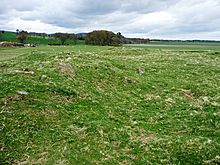|
|
|
|
Green CairnHillfort
|
||||||||||||||||||||||||
|
|
|
Images (click to view fullsize) |
|







|
Fieldnotes |
|
|
The Green Cairn is a hillfort situated to the south west of Fettercairn a stones throw from Balbegno cottage a short walk to the north. This is/was a superb site, on a superb day (fair degree of hindsight here!!) and one I've wanted to visit for a long, long time. A lot of important Scottish history has happened here so a lot of folklore. The fort is some 50 meters in length by 18 meters wide. Ramparts still exist most of the way round with a possible entrance on the north east. Several trenches can be still be seen, the remains of excavation work. Part of the wall beneath the ramparts contains stonework from original. Vitrified rock can also be seen along with a long dried out bog. This was built with great all round views but would have taken some amount of defending, it isn't very high, maybe there was a great deal of boggy stuff all round. I'd like to think so. With that it was away to my favourite part of Scotland in the east end of Glasgow, via Templewood, to watch the modern day Celts. Visited 4/05/2010. |
6th May 2010ce |
Folklore |
|
|
The large Iron Age ring fort of Green Castle, otherwise known as Queen's Castle or Finella's Castle, is said to have been the site of an early medieval fortress, seat of the maomor or 'great officer' of the Mearns. Here, it was said, Kenneth III was assassinated towards the end of the tenth century. The antiquarian Robert Chambers, writing in 1827, gives an account of the murder drawn from the fourteenth- and fifteenth-century chronicles: Having excited the implacable hatred of a powerful lady, named Fenella, by killing her son in a rebellion, she put on a courteous face, and invited him to her castle, where she had prepared a singular engine, for the purpose of putting him to death. Under pretence of amusing him with the architectural elegance of her mansion, she conducted him to the upper apartment of a tall tower, where, in the midst of splendid drapery and curious sculptures, she had planted a statue of brass, holding a golden apple. This apple, she told him, was designed as a present for his majesty, and she courteously invited him to take it from the hand of the image. No sooner had the king done this, then some machinery was set in motion, which, acting upon an ambuscade of crossbows behind the arras, caused a number of arrows to traverse the apartment, by one of which killed the king. Fenella left the castle before the murder was discovered by the king's attendants, who broke down the door and found their master weltering in his blood. It was said that Fenella made for another castle of hers at a wild place on the coast called, Den-Fenella. Being pursued, she concealed herself amongst the branches of the trees, and as thick forest stretched all the way from one castle to the other, she was able to swing herself along for a distance of about ten miles, and pass over the very heads of her bewildered pursuers. Different accounts can be found of what happened to her after that: some say she was captured and burned, some that she was at last brought to bay near Lauriston Castle, where she chose death over captivity and threw herself from the crags onto the rocks beneath, while a third version holds that she escaped to Ireland. The Lore Of Scotland - A Guide To Scottish Legends Westwood & Kingshill |
14th February 2024ce |
|
'Kenneth the 2nd of Alba, King of Scotland was the son of Malcolm 1 of Alba, King of Scotland. He died at Finella's castle, Fettercairn, Scotland, possibly murdered. He is buried on the Isle of Iona, Argyllshire. Kenneth the 2nd, of Scotland, gained the title Kenneth of Alba. He succeeded to this title during 971. He was possibly killed by Finvela, a noblewoman, whose son was killed by the king. She is said to have lured Kenneth into her home promising to unmask traitors. In one room a statue connected to several hidden crossbows which were set to fire bolts from every side when a golden apple was lifted. After a great feast, at which wine flowed freely, Finvela took her guest to the fatal room and offered him a golden apple as a gesture of peace. As he lifted the apple, he was struck by a hail of bolts.' The Peerage.com |
6th May 2010ce Edited 8th May 2010ce |
Links |
|
RCAHMSWonderful site plus all the bits I don't have a clue about plus a couple of aerial foties. |
6th May 2010ce Edited 6th May 2010ce |

